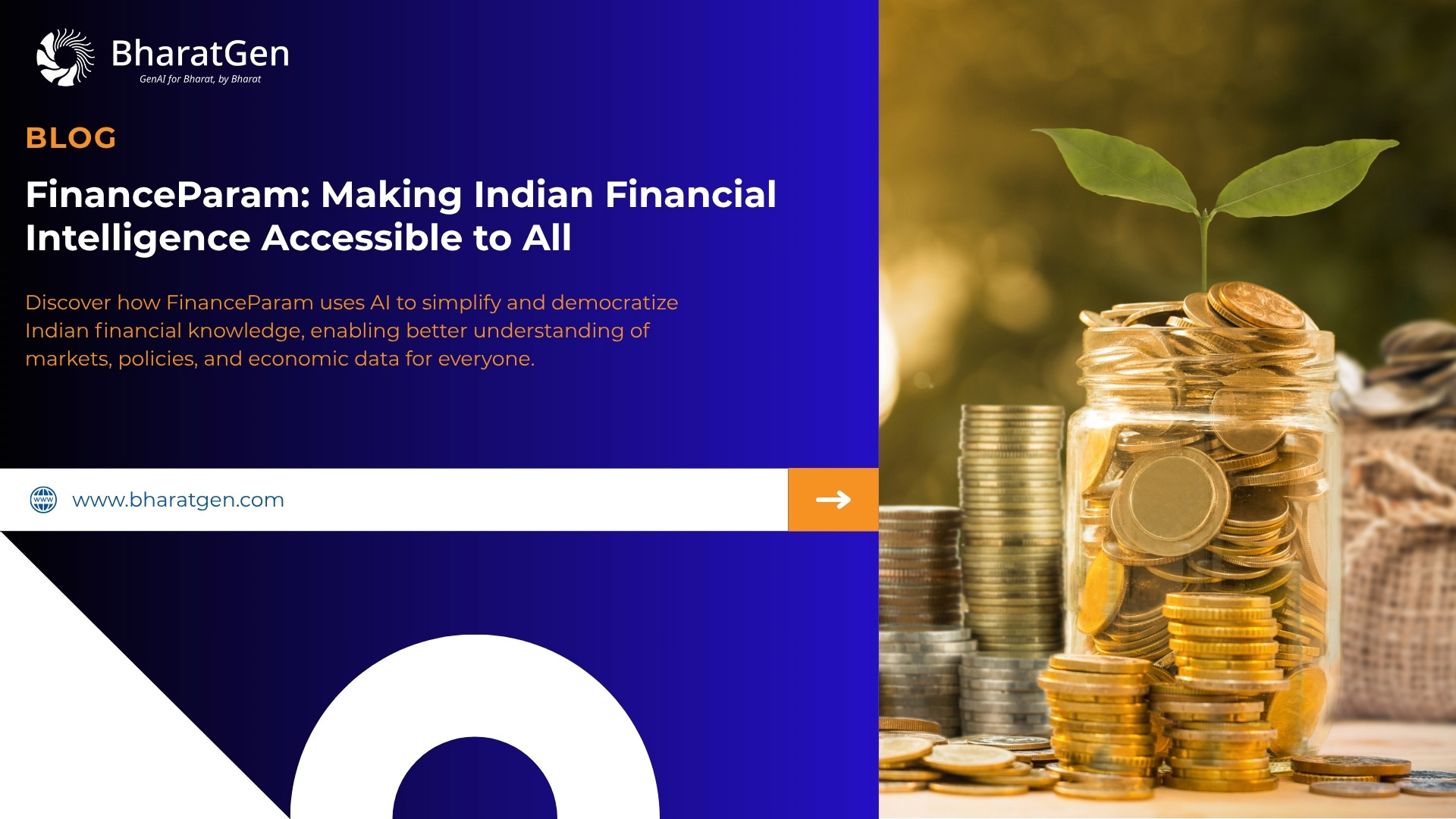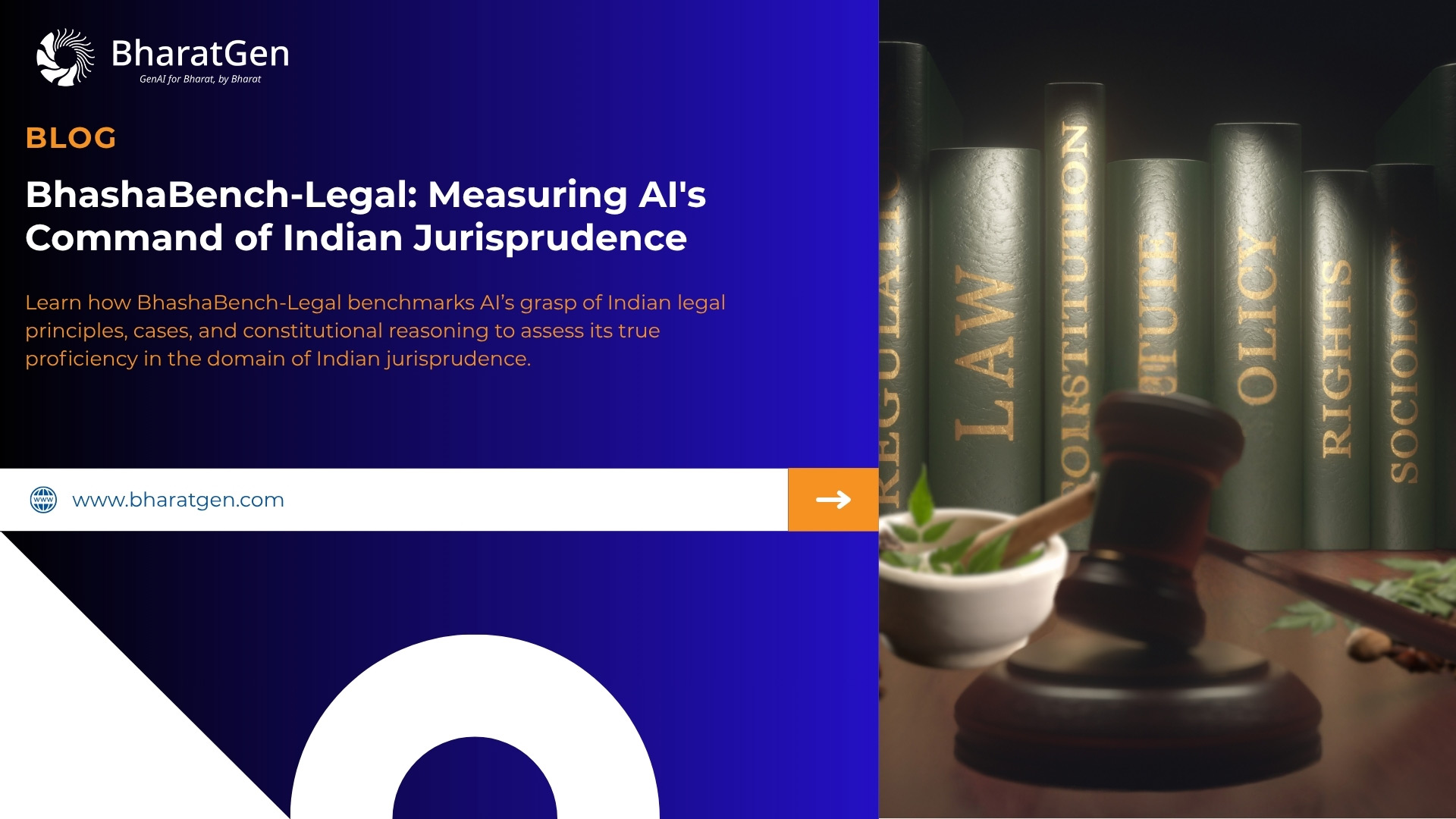A comprehensive analysis of India’s first bilingual financial AI benchmark and its implications for the nation’s digital financial transformation
The Financial AI Challenge in India’s Context
India’s financial landscape is undergoing a remarkable transformation. With over 1.4 billion people navigating everything from traditional banking to digital payments, microfinance to capital markets, the complexity of financial services has never been greater. At the heart of this evolution lies a critical question: Are AI systems equipped to understand and serve India’s unique financial ecosystem?
While artificial intelligence promises to democratize financial services through intelligent advisory systems, automated compliance checking, and personalized financial planning, current AI models face significant challenges when dealing with India-specific financial knowledge. This isn’t merely about language translation – it’s about understanding the nuances of cooperative banking, the intricacies of government schemes like PMJDY and Mudra loans, or the regulatory framework that governs India’s diverse financial institutions.
The introduction of BhashaBench-Finance addresses this critical gap, providing the first comprehensive benchmark specifically designed to evaluate AI systems on Indian financial knowledge. Built from authentic government examination content, it reveals important insights about AI’s readiness to serve India’s financial sector.
Why Existing Financial AI Benchmarks Fall Short for India?
The Global Perspective vs. Indian Reality
The financial AI landscape has seen notable benchmark development in recent years. From China’s comprehensive FinGAIA (407 tasks across financial sub-domains) to the USA’s enterprise-focused FinanceBench (10,231 Q-A pairs), international efforts have made significant strides. MultiFin from Denmark covers 15 languages for cross-linguistic analysis, while specialized benchmarks like InvestorBench evaluate AI trading agents and CFDB focuses on fraud detection systems.
However, these benchmarks, while valuable in their own contexts, present several limitations when applied to India’s financial ecosystem:
Geographic and Regulatory Mismatch: Most benchmarks focus on US, European, or Chinese financial systems, with regulatory frameworks, banking structures, and financial instruments that differ significantly from India’s unique landscape.
Limited Regional Context: Understanding of cooperative banks, regional rural banks, self-help group models, or India-specific government schemes remains largely absent from global benchmarks.
Language Barriers: While some benchmarks cover multiple languages, few provide authentic bilingual coverage that reflects how financial concepts are actually understood and communicated in Indian contexts.
Institutional Knowledge Gap: Knowledge of institutions like NABARD, SIDBI, or the complex web of government financial schemes that form the backbone of India’s inclusive finance initiatives is rarely captured.
Cultural Financial Practices: Traditional concepts like chit funds, community lending practices, or the integration of formal and informal financial systems lack representation in global benchmarks.
The Need for Authentic Indian Financial AI Evaluation
Consider the difference between these approaches:
Traditional Global Benchmark Question: “What is the primary function of a central bank?” (Tests universal financial concepts)
BhashaBench-Finance Question (Hindi): “भारतीय रिज़र्व बैंक द्वारा निर्धारित प्राथमिकता क्षेत्र ऋण के तहत कृषि क्षेत्र के लिए न्यूनतम लक्ष्य क्या है?” (What is the minimum target for agriculture sector under priority sector lending as determined by RBI?)
The difference is clear: while global benchmarks test general financial principles, BhashaBench-Finance evaluates understanding of India-specific policies, regulations, and financial structures that directly impact millions of Indians’ daily financial lives.
Introducing BhashaBench-Finance: India’s Financial Knowledge Benchmark
Comprehensive Coverage of India’s Financial Ecosystem
BhashaBench-Finance represents the most extensive financial knowledge evaluation benchmark created for Indian languages, designed with authenticity and practical relevance at its core. The benchmark currently supports English and Hindi, with plans to expand to additional Indian languages.
Dataset Overview:
Metric | Count | Details |
Total Questions | 19,433 | Rigorously validated across financial domains |
English Questions | 13451 | Comprehensive coverage of financial concepts |
Hindi Questions | 5982 | Culturally authentic regional content |
Subject Domains | 30+ | Complete financial ecosystem coverage |
Topics Covered | 500+ | Granular domain expertise |
Government Exams | 25+ | IBPS, IRDAI, and other authoritative sources |
Spanning the Complete Financial Spectrum
The benchmark draws from over 25 government examinations and certification tests that cover the entire spectrum of India’s financial and banking sector. It integrates memory-based papers, previous year questions, and mock sets across multiple roles and institutions.
Banking and Financial Services
- IBPS (Institute of Banking Personnel Selection) – PO, Clerk, RRB (Officer Scale & Office Assistant)
- Prelims & Mains (previous year papers, memory-based, mock sets)
- Special packages (shift-wise, section-wise, CWE-VIII, and mixed mock tests)
- Prelims & Mains (previous year papers, memory-based, mock sets)
- SBI (State Bank of India) – PO, Clerk, Junior Associates, CBO, Apprentice
- Comprehensive coverage of Prelims & Mains
- Shift-wise memory-based papers (2018–2025)
- Trend-based practice sets and sectional papers
- Comprehensive coverage of Prelims & Mains
Central Banking and Regulation
- RBI (Reserve Bank of India) – Grade B (Phase 1 & 2, memory-based, previous year papers)
- NABARD (National Bank for Agriculture and Rural Development) – Grade A (2018–2022, memory-based PYQs, Phase 1 & 2)
- SEBI (Securities and Exchange Board of India) – Grade A (Phase 1 & 2, memory-based PYGs)
Insurance and Risk Management
- IRDAI (Insurance Regulatory and Development Authority of India) – Grade A (Phase 1, full exam sets)
- LIC, GIC, ECGC, Canara, Syndicate, IDBI, Nainital, Bank of Maharashtra, BOI – Assistant Manager, PO, Executive & Officer-level exams
- SIDBI – Assistant Manager Grade A
Capital Markets and Securities
- SEBI Grade A (compliance & regulation)
- Stock exchange & market-linked papers (investment, securities, settlement knowledge through NISM-style certification mock sets)
Cooperative & Development Finance
- NABARD & SIDBI exams focusing on agriculture, rural development, and MSME finance
- Cooperative and regional rural banking exams included under IBPS RRB
Sectional & Skill-based Sets
- Dedicated sectional tests: English, Reasoning, Quantitative Aptitude, General Awareness
- Job-role aligned tests (e.g., Bancassurance Associate, Credit Processing Officer, MIS Analyst)
Government Finance and Economics
- Commerce and economics competitive exams
- Financial policy and economic survey knowledge
- Government scheme implementation and monitoring
Domain Coverage: 30+ Financial Disciplines
The benchmark spans a wide spectrum of disciplines, combining core finance, applied economics, and interdisciplinary areas:
Core Banking & Financial Services
- Banking Operations, Retail & Corporate Banking, International Trade Finance
- Financial Markets, Capital Markets, Portfolio Management
Corporate Finance & Investment
- Corporate Finance, Mergers & Acquisitions, Investment Advisory
- International Finance, Trade & Development Studies
Insurance & Risk Management
- Life, Health, and General Insurance
- Risk Assessment, Actuarial Methods, Regulatory Compliance
Accounting, Taxation & Regulatory Compliance
- Accounting Principles, Auditing, Corporate Governance
- Taxation Laws, RBI/SEBI/IRDAI Guidelines, Anti–Money Laundering Norms
Economics & Development Studies
- Monetary & Fiscal Policy, Economic Surveys, Rural Economics
- Inclusive Finance, Microfinance, Financial Inclusion Schemes
Business & Management Dimensions
- Business Management, Commerce, Marketing & Finance Linkages
- Governance, Policy & Behavioral Finance
Technology & Data-Driven Finance
- Information Technology in Finance, Data Analytics
- Financial Technology, Digital Banking, Cryptocurrency Regulations
Specialized & Interdisciplinary Domains
- Environmental & Sustainable Finance, Energy & Infrastructure Finance
- Healthcare Economics, Science & Technology in Finance
- History, Sociology & Cultural Studies of Finance
- Sports, Media & Finance Linkages, Finance Education
Language, Communication & Problem-Solving Skills
- Professional Communication, General Knowledge, Problem Solving Aptitude
Question Complexity and Format Distribution
Difficulty Levels:
- Easy (33%): Fundamental financial concepts and definitions
- Medium (44%): Applied financial knowledge and problem-solving
- Hard (14%): Complex analysis and multi-step reasoning
Question Types:
- Multiple Choice Questions (92%): Standard evaluation format
- Rearrange the Sequence (4%): Ordering and logical structuring
- Fill in the Blanks (1.5%): Precise terminology knowledge
- Assertion-Reasoning (1%): Logical analysis and justification

Methodology: Building an Authentic Financial Benchmark
Stage 1: Authoritative Content Sourcing
Our process begins with comprehensive collection from trusted government and institutional sources:
- Official Examination Bodies: IBPS, RBI, SEBI, IRDAI, NABARD, SIDBI
- Government Publications: Ministry of Finance reports, RBI bulletins, economic surveys
- Institutional Sources: Banking institutes, financial training academies
- Verification Process: Cross-referencing across multiple official sources with domain expert validation
Stage 2: Advanced Digital Processing
Converting physical examination materials using state-of-the-art technology:
- OCR Technology: Surya model optimized for Indian financial terminology
- Multi-Script Processing: Robust handling of English, Hindi, and financial notation
- Quality Preservation: Maintaining question integrity, formatting, and numerical accuracy
Stage 3: AI-Enhanced Content Refinement
Leveraging advanced language models for content enhancement:
- Language Model: Qwen3-235B for multilingual financial content understanding
- Domain-Aware Processing: Accurate interpretation of financial jargon and regulatory terminology
- Iterative Improvement: Multiple correction passes with consistency validation
Stage 4: Intelligent Domain Classification
Creating meaningful categorization for comprehensive evaluation:
- Official Taxonomy: Initial classification based on examination syllabi and official domains
- AI-Assisted Grouping: Using advanced models to create coherent financial domain clusters
- Hierarchical Organization: Two-level system mapping specific topics to broader financial areas
- Validation Accuracy: 94% accuracy in domain assignment, verified by financial experts
Stage 5: Linguistic and Cultural Validation
Ensuring cultural relevance and linguistic accuracy:
- Expert Review Team: Financial language specialists and subject matter experts
- Cultural Context Check: Verification of India-specific financial concepts and terminology
- Quality Assurance: Grammar, translation accuracy, and regional appropriateness
- Validation Rate: 87% initial accuracy with expert corrections for remaining questions
Stage 6: Financial Domain Expert Review
Final validation by senior financial professionals:
- Expert Panel: Experienced professionals from banking, insurance, capital markets, and regulatory bodies
- Technical Verification: Scientific accuracy and practical relevance assessment
- Real-world Applicability: Ensuring questions reflect actual financial sector challenges
- Expert Approval: 80% of questions validated as technically sound and professionally relevant
Results: Understanding AI’s Financial Knowledge Landscape
This comprehensive evaluation of 29+ language models reveals significant insights into AI capabilities in financial domain understanding, with performance patterns that highlight both strengths and areas for improvement in financial AI applications.
Overall Model Performance Insights
Top Tier Performance
- Leading Models: DeepSeek-v3 (61.48% overall) and Qwen3-235B-A22B-Instruct-2507 (61.43% overall) demonstrate superior financial understanding
- English Performance: Top models achieve 63-64% accuracy on English financial content
- Consistency: Advanced models show reliable performance across diverse financial topics
Multilingual Performance Gap
- Hindi Performance: Leading models drop to 60-67% accuracy in Hindi
- Language Barrier: 8-15% performance decrease indicates significant multilingual challenges
- Regional Language Needs: Clear opportunity for improvement in local language financial understanding
Performance Distribution Analysis
- High Performers (60%+): DeepSeek-v3 (61.48%), Qwen3-235B (61.43%)
- Mid-Tier (30-50%): Gemma-2-27b (45.77%), Qwen2.5-3B (37.26%), gpt-oss-20b (35.73%)
- Lower Tier (<30%): Various smaller models and base versions
- Specialized Domain Gap: Financial knowledge requires focused training beyond general language capabilities

Domain-Specific Performance Patterns
Strongest Performance Areas (75-80% Accuracy)
Banking Fundamentals
- Banking Services: 71.9% (DeepSeek-v3), 71.22% (Qwen3)
- Core Concepts: Fundamental banking operations well understood
- Practical Applications: Strong grasp of everyday banking scenarios
Advanced Financial Topics
- Information Technology Finance: 91.63% (DeepSeek-v3) – highest domain performance
- Business Management: 84.34% (Qwen3) – strategic understanding evident
- International Finance: 85.54% (DeepSeek-v3) – global finance concepts mastered
Moderate Performance Domains (60-75% Accuracy)
Regulatory and Policy Areas
- Governance & Policy: 76.41% (DeepSeek-v3)
- Taxation & Compliance: 74.84% (Qwen3)
- Mixed Results: Reflecting regulatory interpretation complexity
Specialized Finance Areas
- Environmental Finance: 82.74% (Qwen3)
- Healthcare Economics: 78.95% (DeepSeek-v3)
- Emerging Sectors: Variable performance based on training data availability
Challenging Areas (40-60% Accuracy)
Regional and Cultural Finance
- Rural Economics: 80.46% (Qwen3) vs 47.89% (GPT-OSS) – high variance
- Insurance & Risk: 64.29% (Qwen3) – moderate performance
- Cultural Practices: Traditional financial concepts remain challenging
Technical and Mathematical Areas
- Mathematics for Finance: 58.47% (DeepSeek-v3) – quantitative challenges evident
- Data Analytics: 58.27% (DeepSeek-v3) – technical complexity impacts performance
Problem Solving: 47.12% (Qwen3) – multi-step reasoning difficulties

Performance by Question Complexity
Basic Questions (Easy Category)
- Top Performance: 73.49% (DeepSeek-v3)
- Consistent Results: Most models show 35-60% range
- Fundamental Concepts: Well-handled across model spectrum
Advanced Questions (Hard Category)
- Performance Drop: 40.55% (DeepSeek-v3) maximum
- Challenge Area: Complex analysis and multi-step reasoning
- Improvement Needed: Significant gap in advanced financial reasoning
Intermediate Questions (Medium Category)
- Balanced Performance: 59.33% (Qwen3)
- Applied Knowledge: Moderate success in practical applications
- Room for Growth: 60-70% accuracy range achievable

Question Format Performance Analysis
Multiple Choice Questions (MCQ)
- Highest Accuracy: 61.7% (DeepSeek-v3)
- Structured Advantage: Benefits from answer options
- Consistent Performance: Most reliable format across models
Fill in the Blanks
- Strong Performance: 81.82% (DeepSeek-v3)
- Precision Challenge: Requires exact terminology knowledge
- Variable Results: High variance between models
Assertion-Reasoning
- Moderate Success: 67.91% (Qwen3)
- Logical Reasoning: Challenges in financial logic chains
Improvement Area: Better reasoning capabilities needed

Key Insights and Recommendations
Strengths
- Solid Foundation: Strong performance in basic financial concepts
- Technology Integration: Excellent understanding of fintech and IT finance
- Global Perspective: Good grasp of international finance principles
Improvement Areas
- Multilingual Capabilities: Significant need for regional language enhancement
- Complex Reasoning: Advanced analytical skills require development
- Cultural Context: Traditional and regional financial practices need attention
- Mathematical Precision: Quantitative financial analysis needs strengthening
Strategic Implications
- Model Selection: Choose based on specific financial domain requirements
- Training Focus: Prioritize multilingual and complex reasoning capabilities
- Application Design: Consider model limitations in deployment strategies
- Performance Monitoring: Regular evaluation needed for financial AI applications
Model Rankings by Financial Capability
- DeepSeek-v3: Top performer across domains (61.48% overall)
- Qwen3-235B-A22B-Instruct-2507: Strong specialist performance (61.43% overall)
- Gemma-2-27b: Best mid-tier performer (45.77% overall)
- Qwen2.5-3B: Solid baseline performance (37.26% overall)
- gpt-oss-20b: Consistent across categories (35.73% overall)
Real-World Applications and Implications
Financial Services at Scale
The performance insights from BhashaBench-Finance have direct implications for critical financial AI applications:
Digital Banking Assistants: Current limitations in understanding India-specific banking products, government schemes, and regulatory requirements could lead to incomplete or incorrect customer guidance.
Financial Planning Tools: AI systems may struggle to provide appropriate advice on investment products, tax planning strategies, or government savings schemes relevant to Indian investors.
Compliance and Risk Management: Automated systems might miss nuances in regulatory interpretation, potentially creating compliance risks for financial institutions.
Financial Education Platforms: AI-powered educational tools may not effectively explain complex financial concepts in culturally appropriate ways.
Economic and Social Impact
Financial Inclusion: AI systems that don’t understand India’s inclusive finance ecosystem risk excluding millions from digital financial services.
Rural Finance: Limited understanding of agricultural finance, cooperative banking, and rural development schemes could hinder financial penetration in rural areas.
MSME Support: Inadequate knowledge of government schemes for small businesses might limit AI’s effectiveness in supporting entrepreneurship.
Consumer Protection: Gaps in understanding regulatory frameworks could compromise consumer protection in AI-driven financial services.
Sector-Wide Implications
Banking Industry: Need for specialized AI training on Indian banking regulations, products, and customer segments.
Insurance Sector: Requirement for AI systems that understand diverse insurance products, regulatory requirements, and claim processes.
Capital Markets: Importance of AI that comprehends Indian market structures, regulatory framework, and investment instruments.
Fintech Innovation: Critical need for AI that can navigate India’s regulatory landscape while serving diverse customer needs.
Future Directions: Building Financial AI for India
Immediate Development Priorities
Enhanced Data Collection:
- Integration of state-level financial examinations and certifications
- Real-world case studies from Indian financial institutions
- Documentation of traditional and community financial practices
- Current updates on evolving regulations and schemes
Model Development Focus:
- Pre-training on Indian financial content and terminology
- Multilingual capabilities beyond Hindi and English
- Integration of numerical reasoning with contextual understanding
- Adaptive learning for evolving financial regulations
Long-Term Vision
Comprehensive Financial Intelligence: AI systems that understand the complete Indian financial ecosystem, from traditional practices to modern innovations, providing accurate, culturally appropriate, and regulatory-compliant guidance.
Inclusive Financial Technology: Tools accessible across languages, education levels, and geographic regions, supporting both urban professionals and rural entrepreneurs in their financial journeys.
Regulatory-Aware Systems: AI that stays current with India’s evolving financial regulations while maintaining high standards of compliance and consumer protection.
Conclusion: Enabling AI-Driven Financial Inclusion
BhashaBench-Finance illuminates both the potential and limitations of current AI systems in India’s financial context. While leading models demonstrate reasonable performance on fundamental concepts, significant gaps remain in specialized knowledge areas crucial for real-world financial applications.
Key Insights
Domain Specialization Matters: General language capabilities don’t automatically translate to domain expertise, particularly in specialized areas like financial regulation and cultural financial practices.
Cultural Context is Critical: Understanding India’s unique financial ecosystem requires more than translation it demands deep cultural and institutional knowledge.
Multilingual Competency: True financial inclusion requires AI systems that can operate effectively across India’s linguistic diversity.
The Path Forward
Creating AI that genuinely serves India’s financial sector requires:
Collaborative Development: Active partnership between AI researchers, financial institutions, regulators, and community organizations.
Continuous Learning: AI systems that evolve with India’s dynamic financial landscape and regulatory environment.
Inclusive Design: Technology development that considers the needs of all segments of India’s population, from urban professionals to rural entrepreneurs.
Quality Assurance: Rigorous evaluation using benchmarks like BhashaBench-Finance to ensure AI systems meet the standards required for financial applications.
A Catalyst for Innovation
BhashaBench-Finance serves as both a measurement tool and a catalyst for innovation in Indian financial AI. By highlighting current limitations and providing a framework for improvement, it encourages the development of AI systems that can truly serve India’s diverse financial needs.
The benchmark is publicly available on Hugging Face and integrated with LMeval, enabling researchers and practitioners to build upon this foundation. As India continues its journey toward becoming a digitally empowered financial ecosystem, tools like BhashaBench-Finance help ensure that AI development keeps pace with the nation’s financial aspirations.
For India’s financial future and for the millions who depend on accessible, accurate, and culturally appropriate financial services we must continue pushing the boundaries of what AI can achieve in the financial domain. BhashaBench-Finance provides the roadmap for this essential journey.
Access the benchmark: bharatgenai/BhashaBench-Finance
Contact Details
For any questions or feedback, please contact:
- Vijay Devane (vijay.devane@tihiitb.org)
- Mohd. Nauman (mohd.nauman@tihiitb.org)
- Bhargav Patel (bhargav.patel@tihiitb.org)
- Kundeshwar Pundalik (kundeshwar.pundalik@tihiitb.org)




